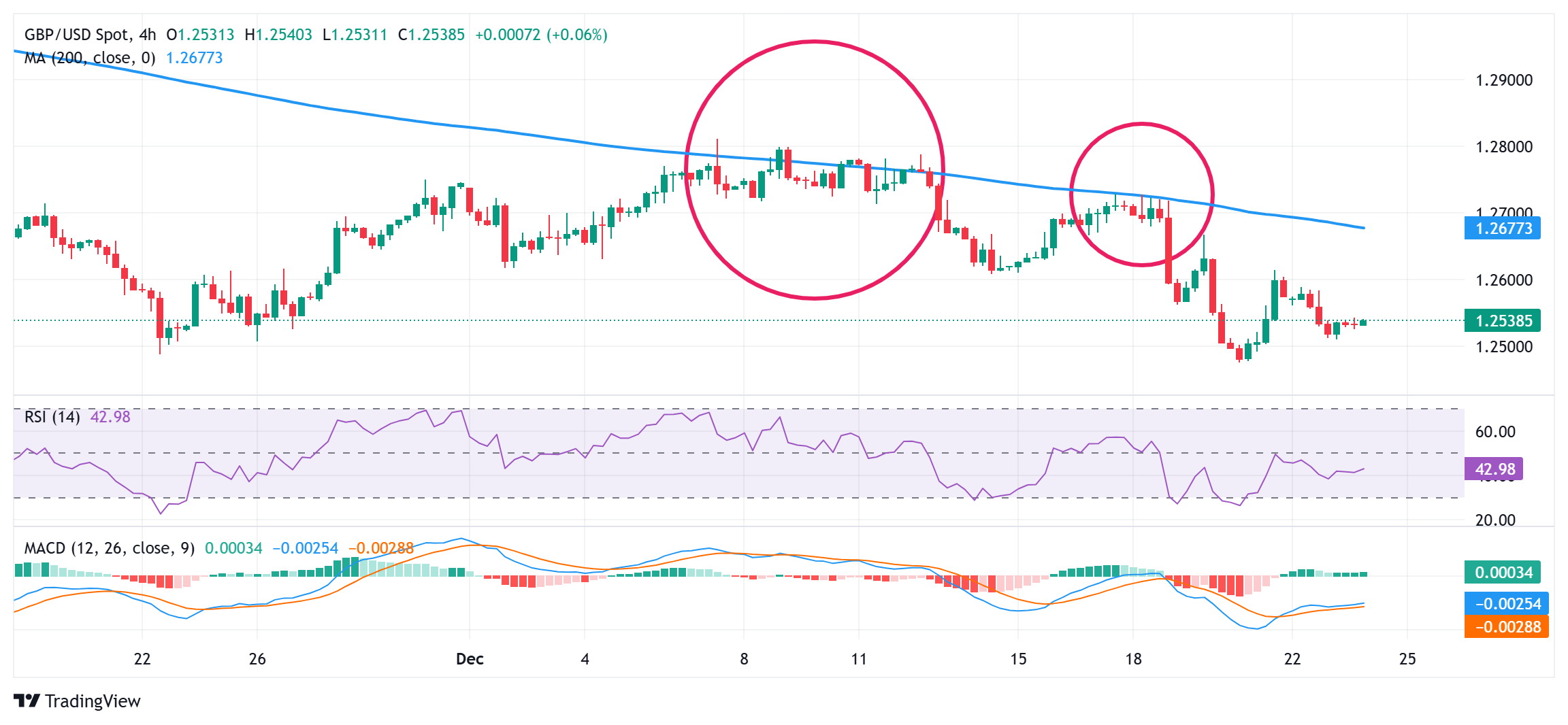GBP/USD Price Forecast: Consolidates below mid-1.2500s, not out of the woods yet
- GBP/USD struggles to gain any meaningful traction and languishes near a multi-month trough.
- The Fed’s hawkish shift underpins the USD and caps the upside amid the BoE’s dovish stance.
- The recent failures near the 200-period SMA hurdle on the 4-hour chart favor bearish traders.
The GBP/USD pair consolidates in a range below mid-1.2500s during the Asian session on Tuesday and remains within striking distance of its lowest level since May touched last week. Moreover, the fundamental backdrop and the technical setup suggest that the path of least resistance for spot prices remains on the downside.
The US Dollar (USD) stands firm near a two-year peak and continues to draw support from the Federal Reserve's (Fed) hawkish signal that it would slow the pace of interest rate cuts in 2025. The British Pound (GBP), on the other hand, is undermined by the Bank of England's (BoE) split vote decision to leave interest rates unchanged and a dovish outlook. This, in turn, validates the near-term negative outlook for the GBP/USD pair.
From a technical perspective, the recent repeated failures near the 200-period Simple Moving Average (SMA) on the 4-hour chart and the lack of any meaningful buying reaffirm the bearish bias. Given that oscillators on the daily chart are holding deep in the negative territory, the GBP/USD pair could challenge the 1.2500 psychological mark. Some follow-through selling will confirm a breakdown and pave the way for deeper losses.
The subsequent fall has the potential to drag spot prices to the May swing low, around the 1.2445 region, en route to the 1.2400 mark and the year-to-day trough, around the 1.2300 round figure. The latter should act as a strong base for the GBP/USD pair and help limit the downside amid the year-end thin trading volumes.
On the flip side, the 1.2600 mark is likely to act as an immediate hurdle, above which a bout of a short-covering could lift spot prices to the 200-period SMA on the 4-hour chart, currently pegged near the 1.2680 region. This is closely followed by the 1.2700 round figure, which if cleared decisively will set the stage for some meaningful recovery and push the GBP/USD pair towards the 1.2735 zone intermediate hurdle en route to the 1.2775-1.2780 supply zone.
GBP/USD 4-hour chart
Pound Sterling FAQs
The Pound Sterling (GBP) is the oldest currency in the world (886 AD) and the official currency of the United Kingdom. It is the fourth most traded unit for foreign exchange (FX) in the world, accounting for 12% of all transactions, averaging $630 billion a day, according to 2022 data. Its key trading pairs are GBP/USD, also known as ‘Cable’, which accounts for 11% of FX, GBP/JPY, or the ‘Dragon’ as it is known by traders (3%), and EUR/GBP (2%). The Pound Sterling is issued by the Bank of England (BoE).
The single most important factor influencing the value of the Pound Sterling is monetary policy decided by the Bank of England. The BoE bases its decisions on whether it has achieved its primary goal of “price stability” – a steady inflation rate of around 2%. Its primary tool for achieving this is the adjustment of interest rates. When inflation is too high, the BoE will try to rein it in by raising interest rates, making it more expensive for people and businesses to access credit. This is generally positive for GBP, as higher interest rates make the UK a more attractive place for global investors to park their money. When inflation falls too low it is a sign economic growth is slowing. In this scenario, the BoE will consider lowering interest rates to cheapen credit so businesses will borrow more to invest in growth-generating projects.
Data releases gauge the health of the economy and can impact the value of the Pound Sterling. Indicators such as GDP, Manufacturing and Services PMIs, and employment can all influence the direction of the GBP. A strong economy is good for Sterling. Not only does it attract more foreign investment but it may encourage the BoE to put up interest rates, which will directly strengthen GBP. Otherwise, if economic data is weak, the Pound Sterling is likely to fall.
Another significant data release for the Pound Sterling is the Trade Balance. This indicator measures the difference between what a country earns from its exports and what it spends on imports over a given period. If a country produces highly sought-after exports, its currency will benefit purely from the extra demand created from foreign buyers seeking to purchase these goods. Therefore, a positive net Trade Balance strengthens a currency and vice versa for a negative balance.







